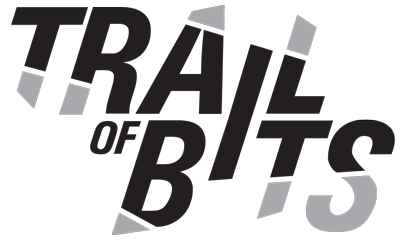The US Army’s Program Executive Office for Intelligence, Electronic Warfare and Sensors (PEO IEW&S) recently issued a request for information (RFI) on methods to implement and automate production of an artificial intelligence bill of materials (AIBOM) as part of Project Linchpin. The RFI describes the AIBOM as a detailed […]
At Trail of Bits, we pride ourselves on making our best tools open source, such as Slither, PolyTracker, and RPC Investigator. But while this post is about open source, it’s not about our tools… In 2023, our employees submitted over 450 pull requests (PRs) that were merged into non-Trail of Bits repositories. This demonstrates our […]
Late last month, DARPA officially opened registration for their AI Cyber Challenge (AIxCC). As part of the festivities, DARPA also released some highly anticipated information about the competition: a request for comments (RFC) that contained a sample challenge problem and the scoring methodology. Prior rules documents and FAQs released by DARPA painted […]
We are disclosing LeftoverLocals: a vulnerability that allows recovery of data from GPU local memory created by another process on Apple, Qualcomm, AMD, and Imagination GPUs. LeftoverLocals impacts the security posture of GPU applications as a whole, with particular significance to LLMs and ML models run on impacted GPU […]
AI is becoming ubiquitous, as developers of widely used tools like GitHub and Photoshop are quickly implementing and iterating on AI-enabled features. With Microsoft’s recent integration of Copilot into Windows, AI is even on the old stalwart of computing—the desktop. The integration of an AI assistant into an entire operating system is […]
TL;DR: We identified 11 security vulnerabilities in YOLOv7, a popular computer vision framework, that could enable attacks including remote code execution (RCE), denial of service, and model differentials (where an attacker can trigger a model to perform differently in different contexts). Open-source software […]
Dan Guido, CEO The second meeting of the Commodity Futures Trading Commission’s Technology Advisory Committee (TAC) on July 18 focused on the effects of AI on the financial sector. During the meeting, I explained that AI has the potential to fundamentally change the balance between cyber offense and defense, and that we need security-focused benchmarks […]
The Office of Science and Technology Policy (OSTP) has circulated a request for information (RFI) on how best to develop policies that support the responsible development of AI while minimizing risk to rights, safety, and national security. In our response, we highlight the following points: To ensure that AI […]
The National Telecommunications and Information Administration (NTIA) has circulated an Artificial Intelligence (AI) Accountability Policy Request for Comment on what policies can support the development of AI audits, assessments, certifications, and other mechanisms to create earned trust in AI systems. Trail of Bits has submitted a response to the […]
Is artificial intelligence (AI) capable of powering software security audits? Over the last four months, we piloted a project called Toucan to find out. Toucan was intended to integrate OpenAI’s Codex into our Solidity auditing workflow. This experiment went far […]
Tl;dr: Trail of Bits has launched a practice focused on machine learning and artificial intelligence, bringing together safety and security methodologies to create a new risk assessment and assurance program. This program evaluates potential bespoke risks and determines the necessary safety and security measures for AI-based systems. If you’ve read any news over the past […]
tl;dr: Our publicly available Semgrep ruleset now has 11 rules dedicated to the misuse of machine learning libraries. Try it out now! Picture this: You’ve spent months curating images, trying out different architectures, downloading pretrained models, messing with Kubernetes, and you’re finally ready to ship your sparkling new machine learning (ML) product. […]
Originally published August 3, 2021 During my Trail of Bits winternship and springternship, I had the pleasure of working with Suha Hussain and Jim Miller on PrivacyRaven, a Python-based tool for testing deep-learning frameworks against a plethora of privacy attacks. I worked on improving PrivacyRaven’s versatility by adding compatibility for services […]
Many machine learning (ML) models are Python pickle files under the hood, and it makes sense. The use of pickling conserves memory, enables start-and-stop model training, and makes trained models portable (and, thereby, shareable). Pickling is easy to implement, is built into Python without requiring additional dependencies, and supports serialization of custom […]
Trail of Bits has manually curated a wealth of data—years of security assessment reports—and now we’re exploring how to use this data to make the smart contract auditing process more efficient with Slither-simil. Based on accumulated knowledge embedded in previous audits, we set out to detect similar vulnerable code snippets […]
